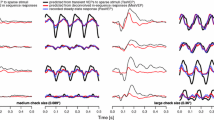Abstract
Pattern reversal visually evoked cortical potentials were recorded from 70 normal volunteers, aged from 4 to 70 years. Eleven reversal frequencies between 1 and 20 rev/sec were presented. The progressive reduction in the amplitude of the P100 component with age for lower frequency ranges was shown up to the age decade of 30–39 years and the temporal tuning curve became a constant pattern after 40 years. However, there was a trend that the maxima of the tuning curve shifted toward lower frequencies with age after 30 years.
Similar content being viewed by others
References
Adachi-Usami E (1981) Human visual system modulation transfer function measured by evoked potentials. Neurosci Let 23: 43–47.
Adachi-Usami E and Lehmann D (1983) Luminance effects on latency and topography of average pattern-evoked potentials. Doc Ophthalmol Proc Series 37: 353–360.
Adachi-Usami E and Morita Y (1979) Temporal contrast sensitivity characteristics of human vision as obtained by VECPs to checkerboard stimuli. Proc 16th ISCEV Sympos Morioka, pp 249–257.
Asselman P, Chadwick DW and Marsden CD (1975) Visual evoked responses in the diagnosis and management of patients suspected of multiple sclerosis. Brain 98: 261–282.
Cavonius CR and Sternheim CE (1972) A component of electrophysiological and psychophysical temporal modulation transfer functions of human vision. In: The Visual System: Neurophysiology, Biophysics, and Their Clinical Applications, ed Arden GB. London: Plenum Press pp 223–235.
Celesia GG and Daly RF (1977) Effects of aging on visual evoked responses. Arch Neurol 34: 403–407.
De Lange H (1958) Research into the dynamic nature of the human foveacortex systems with intermittent and modulated light. 1. Attenuation characteristics with white and coloured light. J Opt Soc Am 48: 777–784.
Gartner S and Henkind P (1981) Aging and degeneration of the human macula. 1. Outer nuclear layer and photoreceptors. Br J Ophthalmol 65: 23–28.
Halliday AM, Barrett G, Carroll WM and Kriss A (1982) Problems of defining the normal limits of the VEP. In: Clinical Application of Evoked Potentials in Neurology, eds Courjon J, Mauguiere F and Revol M. New York: Raven Press, pp 1–9.
Kulikowski JJ (1971) Some stimulus parameters affecting spatial and temporal resolution of human vision. Vision Res 11: 83–93.
Moskowitz A and Sokol S (1980) Spatial and temporal interaction of pattern-evoked cortical potentials in human infants. Vision Res 20: 699–707.
Regan D (1972) Evoked Potentials in Psychology, Sensory Physiology and Clinical Medicine. London: Chapman & Hall.
Shaw NA and Cant BR (1980) Age-dependent changes in the latency of the pattern visual evoked potential. Electroencephalogr Clin Neurophysiol 48: 237–241.
Snyder EW, Dustman RE and Shearer PE (1981) Pattern reversal evoked potential amplitudes: life span changes. Electroencephalogr Clin Neurophysiol 52: 429–434.
Spekreijse H (1978) Maturation of contrast EPs and development of visual resolution. Arch Ital Biol 116: 358–369.
Spekreijse H and van der Tweel LH (1974) Stimulus and visually evoked potential. Doc Ophthalmol Proc Series 4: 269–284.
Sternheim CE and Cavonius CR (1972) Sensitivity of the human ERG and VECP to sinusoidally modulated light. Vision Res 12: 1685–1695.
Van der Tweel LH and Estévez O (1974) Subjective and objective evaluation of flicker. Ophthalmologica 196: 70–81.
Wright CE and Drasdo N (1985) The influence of age on the spatial and temporal contrast sensitivity function. Doc Ophthalmol 59: 385–395.
Wright CE, Williams DE, Drasdo N and Harding GFA (1985) The influence of age on the electroretinogram and visual evoked potential. Doc Ophthalmol 59: 365–384.
Author information
Authors and Affiliations
Rights and permissions
About this article
Cite this article
Adachi-Usami, E., Hosoda, L. & Toyonaga, N. Effects of aging on the temporal frequency characteristics determined by pattern visually evoked cortical potentials. Doc Ophthalmol 69, 139–144 (1988). https://doi.org/10.1007/BF00153694
Issue Date:
DOI: https://doi.org/10.1007/BF00153694




